Jeep sells a lot of 4x4s – as in, SUVs with four-wheel-drive. It also sells some that look like 4x4s but are more like the crossovers everyone else sells a lot of.
One of these models also offers more than just looks.
The Jeep Compass also does.
Or rather, it can do things that most crossovers cannot – because it has a few things functionally in common with the 4x4s it looks a lot like.
What It Is
The Compass is a compact crossover that can be ordered with a gear-reduction feature (in Trailhawk versions) that uses the transmission to provide low-speed leverage for slogging through deep snow, mud and so on that’s similar to what you’d get from a 4×4’s two speed transfer case and 4WD Low Range gearing.
Without the additional weight (and expense) of the transfer case.
Also included – with the Trailhawk – is a lifted suspension, more ground clearance, all-terrain tires, tow hooks and the capability to ford 20 inches of water.
Prices start at $28,400 for the Sport trim. Like most crossovers, this one comes standard with a light-duty all-wheel-drive system. It also comes with a new – and stronger – standard engine.
The top-of-the-line Trailhawk version already mentioned stickers for $35,745.
What’s New for 2023
The big news is a new turbocharged 2.0 liter engine – for all Compass trims, including the base Sport. It replaces the previously standard 2.4 liter engine.
All-wheel-drive is also standard in all trims now.
The bad news is the price has gone up about $2,000 – and the previously available manual transmission no longer is.
What’s Good
Additional (available) off-pavement and poor-weather capability.
More standard power.
Appetite’s about the same as it was before.
What’s Not So Good
No more available manual transmission.
Significant increase in the standard price.
The turbo-diesel engine Jeep offers in Europe and other markets isn’t available here.
Every Compass comes standard with – wait for it! – a 2.0 liter turbocharged four cylinder engine – which seems to be the Universal Standard Engine, in that is a fact that almost every new vehicle, regardless of make or model, comes standard with a 2.0 liter turbocharged four cylinder engine.
This probably explains why all of these engines are underneath what appears to be the same black plastic cover.
But why are they all 2.0 liters? And why the turbo? It is because that particular size is just right – to meet government regulations. The turbo is there to boost what would otherwise be too small to meet customer expectations – as regards power/performance. Government regulations are also why the Compass is no longer available with a manual transmission – as it was, previously. It is harder to fine-tune a vehicle with a manual transmission to meet government regs than it is to program one with an automatic. Consistency matters when a fraction of a mile-per-gallon difference matters.
Which it does, very much – when it comes to the regs.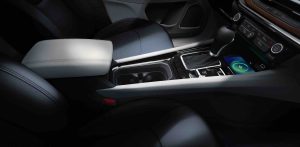
Thus, the new (standard) 2.0 liter engine – and the no-longer-available manual transmission.
On the upside, the new 2.0 engine makes 200 horsepower – an uptick of 23 vs. the 177 produced by the previously standard 2.4 liter engine (which did not have a turbo). There is also much more torque – and much sooner. The new engine develops 221 ft.-lbs. at just 1,750 RPM vs. 172 ft.-lbs. at 3,900 RPM previously.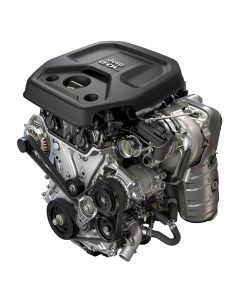
And the city/highway mileage of the ’23 Compass with the 2.0 liter engine (and the standard eight speed automatic transmission that it’s paired with) is about the same as delivered by the ’22 Compass with the 2.4 liter engine. The ’23 rates 24 city, 32 highway while the ’22 rated 22 city, 31 highway. In real-world driving, the mileage of the ’22 Compass with the 2.4 liter engine was probably worse – on account of all the weight it had to pull around.
With the new engine, the Compass can get to 60 in about 7.7 seconds – a seat-of-the-pants noticeable uptick from last year’s 2.4 liter-equipped model, which needed nine seconds to make the same run.
All-wheel-drive is now standard, as per above – which isn’t uncommon in the crossover class. What is uncommon is the Trailhawk’s gear-reduction feature, which provides additional low-speed leverage (a 20:1 crawl ratio) when engaged. Trailhawk’s also get a more aggressive 4.398 final drive ratio (3.73 is otherwise standard). This gives the little Compass rock-crawling and mud-slogging capabilities comparable to a 4×4 SUV such as the Wrangler, for instance.
The Active Drive system has Auto, “4×4” and Neutral settings.
It isn’t as heavy-duty as the 4×4 (with Low range) drivetrain in the Wrangler – nor is the Compass, itself, as heavily built as the Wrangler (which weighs about 500 pounds more than the Compass) but the point is it’s heavier-duty (and more capable) than is common in the crossover class. The ideal being to sell people who want or need more capability than most crossovers offer – without having to buy a 4×4 SUV to get it.
This small Jeep can also pull up to 2,000 lbs.
That’s about 500 pounds more than most, with the exception of rivals such as the Toyota RAV4 with the TRD upgrades, which is rated to pull 3,000 lbs.
Ditto the Subaru Forester Wilderness.
Speed is, in fact, a question of money.
You’ll pay $1,615 more to get into a base trim Compass Sport this year vs. last, But you’ll get where you’re pointed more quickly. The zero to 60 thing isn’t so much the point as the being able to build up speed quickly enough to able to comfortably merge with traffic going faster than you are – and to have the power available to pass traffic going slower.
The Compass is not “fast.” But it is no longer slow.
It was, before. And more, it felt – and sounded – slower. Because it was necessary to really beat on that overmatched 2.4 liter engine to get the 3,600-plus pound Compass moving. That latter figure, by the way, is comparable to what a muscle car from the ’70s like my 1976 Pontiac Trans Am weighs. It wasn’t fast when it was new, either – having a V8 that made about the same horsepower (just 200, as surreal as it sounds) as the four that powers the Jeep. But the V8 did make a lot of torque – some 345 ft.-lbs. – and for that reason, it moved along well enough to give the impression it wasn’t as slow as it actually was.
It’s a similar thing here in that you do not have to flog the 2.0 engine to get the Jeep moving. The 221 ft.-lbs. of torque is comparable to the twist you’d have on tap if there were a V6 under the hood and – more to the point – it is what’s necessary to make 3,600 lbs. of Jeep not feel like two tons of lead.
Mid-sevens to 60 is also about as quick as my Trans-Am was when it was new, too.
Another appealing thing about the Compass is that its transmission is not a CVT (continuously variable) transmission, a type of transmission that is very common in the class. CVTs have their merits – the chief one being they shift seamlessly, because they do not shift at all. Instead, they vary the range, continuously – which is an efficiency advantage. CVT-equipped vehicles typically get about 3 or so MPGs better gas mileage than an otherwise identical vehicle with a conventional automatic.
But it is also durability disadvantage.
CVTs typically have a metal band or belt that expands and contracts, so as to vary the range, the CVT analog of changing gears. But that belt/band is the CVT’s weak point, as expansion and contraction eventually – inevitably – weaken the metal. When the band breaks, the CVT is junk. You don’t rebuild.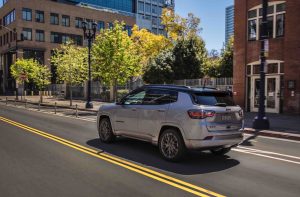
You replace.
A traditional automatic, with gears that shift, is generally more long-term reliable and is more able to handle hard use – which is particularly relevant if the vehicle it’s installed in touts being designed to handle it.
There is also the matter of feel – which is subjective but no less important for being so. CVT automatics feel (and sound) different. Not necessarily bad – or better. But different. And differences matter to people. If you prefer the feel (and sounds) of a transmission that shifts you will like this Jeep’s transmission.
It’s just a shame about the manual transmission you can’t get anymore. But don’t blame Jeep.
Thank the government. And the same goes for the turbo-diesel engine Americans aren’t allowed to buy anymore, either.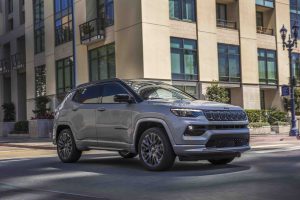
At The Curb
The Compass looks more like the 4x4s it emulates – right down to the “4×4” badges on its liftgate. This puts some visual separation – in addition to the functional separation – between it and the run-of-the mill crossovers in the class. Not that there’s anything wrong with them. But many of them are largely the same-same.
Something else this Jeep has in common with the 4x4s it emulates is a bit less cargo room than some of the other crossovers in the class: 27.2 cubic feet behind the second row and 59.8 cubic feet with the second row down. VW’s Taos – which is about the same size as the Compass – has 65.9 cubic feet of total cargo capacity. On the other hand, the slightly larger Honda HR-V only has 55.1 total cubic feet of capacity with the second row down – and neither of these two offer the notched-up capability you can get in the Jeep.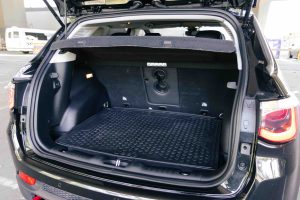
Toyota’s RAV4 does offer notched-up capability (if you buy the TRD version) but it costs about $2k more ($37,595) than a Compass Trailhawk and it looks like the crossover it is. Similarly the Wilderness version of the Subaru Forester. It costs less ($34,320) than the Compass Trailhawk but it still looks like the crossover it is.
All trims come standard with an iPad-like touchscreen sprouting from the center stack – the latter becoming as “universal” as the 2.0 liter turbocharged engine. On the upside, it’s an easier-to-use touchscreen than look-alikes because there are knobs below it that you can use to raise or lower the volume and to change the channel. This is a huge plus because it is not necessary to take your eyes (and attention) off the road to change the station or adjust the volume.
One thing that’s missing (besides the formerly available manual transmission) is a pull-up/manual emergency brake lever – a functionally helpful thing to have off-roading because you can use it to control the rear wheels. Electrically activated parking brakes don’t allow that.
Another thing – that’s there but hard to use – is the 12v power point, which is located on the backside of the center console, where only people in the second row can reach it. It’s a a stretch to run an accessory cord for a radar detector from there to up front – and then you have that cord dangling in your way from front to back.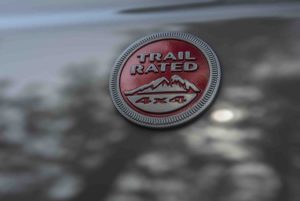
ASS – Jeep calls it Engine Stop Start Technology – is standard but there is an easy-to-use OFF button that can be used to disable this obnoxious “feature” almost no one seems to want but which is standard in practically every new vehicle, because the government wants it. Well, the government’s regs make it necessary for the manufacturers to install it – in order to comply with those regs.
The Bottom Line
Though not really a 4×4, the Compass isn’t just another crossover, either.
. . .
If you like what you’ve found here please consider supporting EPautos.
We depend on you to keep the wheels turning!
Our donate button is here.
If you prefer not to use PayPal, our mailing address is:
EPautos
721 Hummingbird Lane SE
Copper Hill, VA 24079
PS: Get an EPautos magnet or sticker or coaster in return for a $20 or more one-time donation or a $10 or more monthly recurring donation. (Please be sure to tell us you want a magnet or sticker or coaster – and also, provide an address, so we know where to mail the thing!)
My eBook about car buying (new and used) is also available for your favorite price – free! Click here. If that fails, email me at EPeters952@yahoo.com and I will send you a copy directly!


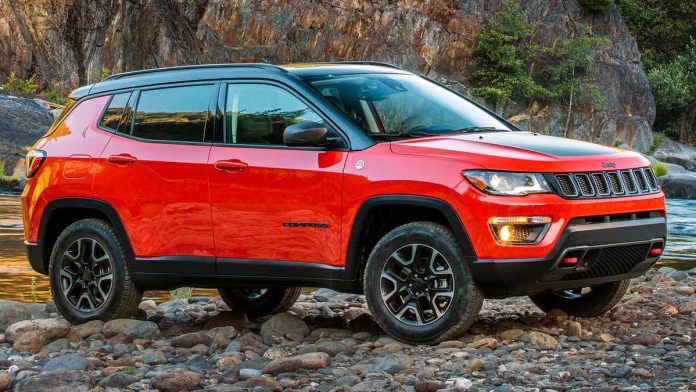

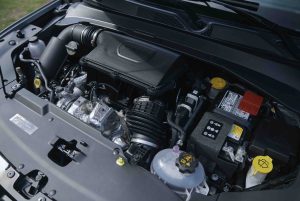
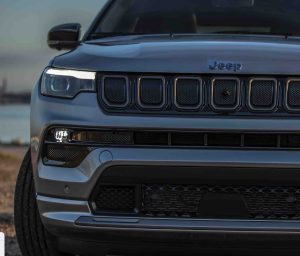
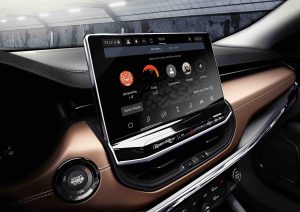








A friend of mine has what I believe is a 1983 Jeep Cherokee with a 4 cyl and a manual. I think it runs. Maybe I should take it off his hands. He has 10 old cars on his 2.5 acre lot.
Hi Greg,
You should. I would, if I were able! No kidding. Vehicles like that Jeep are going to be worth their weight in precious metals soon. Because they are precious metal.
There’s a second reason for the 2.0L turbo engine, yes, it’s related to regulation, but 0.5L per cylinder, with a roughly square stroke/bore ratio is the engineering sweet spot for efficiency. If you want to make power efficiently with a turbo, you will end up with this ratio, eg, 3.0L V6, 4.0L V8 and so forth. Sadly, those other configurations are almost non existent in cars meant for the hoi polloi.
Increasing efficiency standards did force everyone to converge on the most efficient layout. Just like all crossovers and sedans have the same shape, except for plastic accent panels, due to the vice-like grip of crash requirements and aerodynamic requirements.
It’s a bummer to lose variety. Long-stroke engines are low RPM torque monsters, while short stroke engines rev high, and both sound very different from each other. Now, everything’s going to sound like an angry vacuum cleaner at full throttle ,and a rattly 4-cylinder at low throttle.
You read a few sentences to find out about a car you don’t really know much about, you know, you’re interested in what the review says.
Next thing you know, you’ve read the whole review and begin to search for a Jeep Compass with a manual transmission. Found a 2016 for 15,000 dollars and not many miles.
I have to seriously consider a different vehicle in the near future since one is kind of nickel and dime-ing me by the hundreds of dollars, might be time for a change. Don’t want too much of a reversal of fortune, but those things happen more often than not.
Other than that, the birds still sing every morning.
In the summertime living is easy.
Did Bill Gates start the fires in Canada to achieve the dimming of the sun?
Might want to call Bill in for questioning. Too many times Bill is suspect. Always, anyhow.
Place a call to Charles Martel, The Hammer, to bring some peace and quiet to France.
Looks like they finally put a decent drive train in this thing, albeit a turbo. It’s an attractive package but Jeeps aren’t known for their reliability. MIM. Pricey as well but deep discounts are starting to appear. At least it’s not a weird hybrid contraption like RAM is putting out. Stellantis. From famine to feast on inventory.
Hi Vic,
This thing with the turbo diesel you can’t get here – and the manual no longer available here – would be a solid little runabout and appealing vs. the endlessly homogenous rest-of-them. But, as you say, at least it’s not “electrified.”
Yet.
Just doesn’t say “jeep” to me. I get that the grocery store class needs to be catered to, but part of the allure of a brand is what that brand means.
Another AWD mini-ute auto w/ a 2.0L is more of the same old thing that doesn’t stand out or give a reason to buy it over another.
Am curious to know who will be fording 20 inches of water in this.
Remember in the late 40’s throughout time any Jeep can just be rwd not 4wd so a 1977 Jeep nor a 40’s,60’s,80’s Jeep in rwd and white wall tires doesn’t scream Jeep to me either…Jeep was always more than just serious off road vehicles!
These are all 4wd in base trim and 200 hp turbo thats a 7 second range 0-60 that is more capable than a 1990’s Cherokee stock vs stock Compass TrailHawk! For a low priced(well not $80,000 as the norm today for a mid size suv) it is a decent ride..
As for being the norm now for 2.0 turbo 4 cyl that’s the Governments fault! We would probably have a diesel option and with Chrysler probably they would have found a way to put the 797 hp Hellcat Redeye 6.2 Supercharged Hemi V8 in it! But Government killed all cars! So,200 hp 2.0 Turbo it is,realistically they probably would have offered a 360 hp 2.0 Turbo if it wasn’t for the feds!
As for forging in deep water,i would recommend that in ANY new vehicle,no matter the brand..Toyota,Ford Bronco etc..etc..Electronics don’t like water..A 1979 Jeep would be better in driving in 50 feet of water,draining the water from the engine/trans/diffs and starting it up and go! New cars cant do that due to electronic dash,computers etc..With the ecu they would never run!
FYI: my niece bought a new 2023 Turbo Compass and I drove it,was expecting disappointment but actually didn’t mind it,people should check these out..This 2.0 Turbo has been out for a few years already albeit more hp in Cherokee,Grand Cherokee,Wrangler so its proven to be reliable…
Jim H….funny you should mention leisure suits, I remember back in the early ’70s my mom bought my father one, it was sort of a baby blue….I don’t think he ever wore it in public.
With a look like this, probably one could get a job in the fedgov as a diversity hire:
https://tinyurl.com/5yyah3td
Sam Brinton’s untimely departure left an enormous vacuum to be filled. 🙁
I really like these reviews. Eric points outs things that are meaningful if you want a functional, durable, somewhat overengineered car. This may our replacement for our 1.5L AWD Escape, which had its engine replaced at 28K miles under warranty for a design flaw and where routine water pump replacements cost $2K because of high labor costs due to 8 hours needed to just get to the part. When I asked the mechanic why he said that engineers are not mechanics. Noisy car too, otherwise it is great.
Thanks for the kind words, Greg!
I try hard to provide context and meaningful info to help inform people reading about these vehicles I test drive. By the way, I will embed a video walk-around when I get time to upload it. Speeds are glacial out here in The Woods!
Maybe I am just getting old and cranky , but the more I see them, the more I despise “info-tainment” screens in all new vehicles. If a car or truck for that matter can’t have have..rotary dials, levers or knobs for the heat and AC its not for me. Don’t get me started on digital instrumentation, all gauges should be round and analog as God, VDO and Stewart-Warner intended.
Seconded. One is reminded of the early days of color TeeVee, when the “set” was displayed in the living room like a piece of furniture, often in walnut or mahogany cabinetry. Now in designer homes, the large flat screen is discreetly hidden or retractable. Everybody’s got one, and it confers no status.
Stupid flat screens littering the dash (e.g. third photo above) are WAY out of proportion, and an aesthetic disaster. It’s a giant cellphone-like codpiece. For the sake of decency, the huge protruding thing should be retractable. And doubtless will be in due course, as this silly fad goes the way of lime-green polyester leisure suits.
I, too am waiting for the abomination of flat tablet looking screens to be relegated to the landfill of automotive history. Even cars like the Mercedes S-class have a cheap looking, ill fitting screen affixed to the “dash.” I don’t even know what to call lit anymore. I won’t step foot in a car made after 2017 for that reason.
You can always push the button on the steering wheel and tell the car to set the temperature.
My son bought a 2021 Compass and immediately showed me (in the middle of July) how he could say, “Set the passengers temperature to 80 degrees”.
More of a novelty than anything. It’s easy to just set the temperature with the buttons.
As far as the radio goes, almost every car has buttons on the back on the steering wheel for volume and channels, pressing the center of those usually changes inputs and bands.